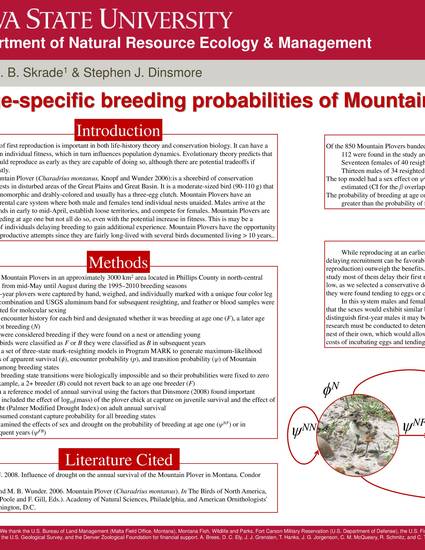
Presentation
Age-specific breeding probabilities of Mountain Plovers in Montana
Natural Resource Ecology and Management Conference Papers, Posters and Presentations
Document Type
Poster
Disciplines
Conference
5th North American Ornithological Conference
Publication Date
8-1-2012
Geolocation
(49.261226, -123.1139268)
Abstract
The age of first reproduction is important in both life-history theory and conservation biology. It can have a large impact on individual fitness, which in turn influences population dynamics. Evolutionary theory predicts that organisms should reproduce as early as they are capable of doing so, although there are potential tradeoffs if breeding is costly.
The Mountain Plover (Charadrius montanus, Knopf and Wunder 2006):is a shorebird of conservation concern that nests in disturbed areas of the Great Plains and Great Basin. It is a moderate-sized bird (90-110 g) that is sexually monomorphic and drably-colored and usually has a three-egg clutch. Mountain Plovers have an uncommon parental care system where both male and females tend individual nests unaided. Males arrive at the breeding grounds in early to mid-April, establish loose territories, and compete for females. Mountain Plovers are capable of breeding at age one but not all do so, even with the potential increase in fitness. This is may be a consequence of individuals delaying breeding to gain additional experience. Mountain Plovers have the opportunity for multiple reproductive attempts since they are fairly long-lived with several birds documented living > 10 years..
Language
en
Citation Information
Paul D. B. Skrade and Stephen J. Dinsmore. "Age-specific breeding probabilities of Mountain Plovers in Montana" Vancouver, BC(2012) Available at: http://works.bepress.com/stephen_dinsmore/11/
